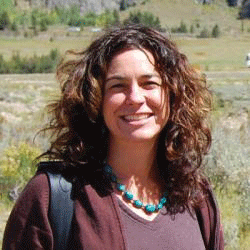Alumna Discusses Refugee Citizenship and Asylum

Alumna Carole McGranahan ’91 discusses refugee settlement patterns in North America.
On Wednesday, November 2, Colgate alumna and Associate Professor of Anthropology at the University of Colorado, Boulder Carole McGranahan ’91 led a discussion titled “Refugee Citizenship: Political Asylum and Tibetan Immigration from South Asia to North America.” This talk focused on McGranahan’s ongoing research on both the formal and informal practices of political subjectivity of Tibetan refugees in diaspora.
McGranahan began the lecture by sharing the story of a Tibetan refugee and her family, whom she met while conducting field research after graduating from Colgate. She used this story to explain the process of obtaining political asylum in both the United States and Canada.
“In the United States, refugees are granted asylum on an individual basis, while Canada grants asylum on a group basis, making it easier for families to enter the country and start their new lives together,” McGranahan said.
Senior Hope DiPaolo was particularly interested in the contrast between American and Canadian refugee law.
“The most thought-provoking part of the lecture was the idea that gaining refugee citizenship in Canada is far easier than in the United States, since their system is not based on proof of being an individual victim of persecution,” DiPaolo said. “This made me think about the way the American system is set up and the possible reasons as to why Canada seems so much more welcoming to refugees on an institutional level.”
McGranahan explained that refugees will typically enter the United States via New York City with tourist visas, and later travel to Buffalo, where they cross the border into Canada. But while preparing for their entrance into Canada, most refugees find comfort at Vive La Casa, where they take shelter during the time leading up to their final journey. Vive La Casa is an inviting community that houses individuals seeking asylum in Canada.
“Vive La Casa is a meeting point not just for Tibetan refugees but for
refugees from countries all over the world,” McGranahan said.
McGranahan said that once refugees achieve Canadian citizenship, they are granted many benefits, such as the ability to purchase a house and have access to government-funded healthcare, better employment opportunities and rights in the workplace. Tibetan refugees tend to settle down in Toronto, more specifically in an area known as Jameson. Refugees who have obtained political asylum have found comfort living in a community filled with fellow refugees and Tibetan natives.
Sophomore D’Jonita Cottrell appreciated learning about the formation of a Tibetan refugee community in Canada.
“The lecture highlighted the emphasis and importance of community in Tibetan culture, and it’s amazing and inspiring to see that this community attempts to rebuild itself despite being thousands of miles away from their geographical home,” Cottrell said.
Cottrell also expressed that the lecture was a great parallel to what she is learning in CORE Tibet.
“In my CORE Tibet class, we often read of Tibetan exiles fleeing to Nepal and India out of a loss of their homes and families but, to me, McGranahan does a great job of depicting the ways in which Canada serves as a temporary Tibetan home for many individuals living there,” Cottrell said.






